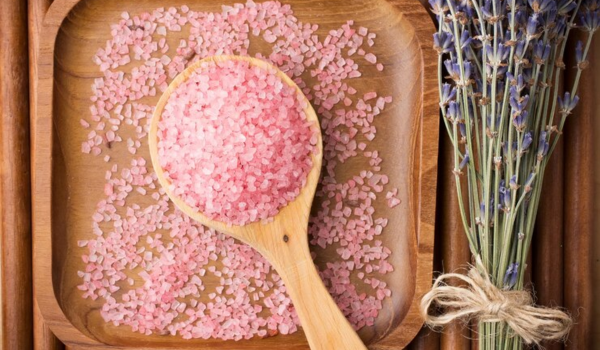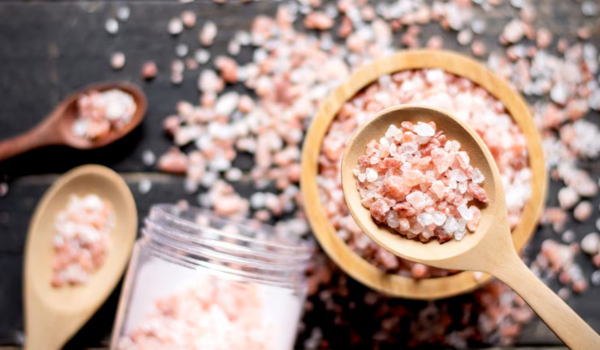Pink Himalayan Salt Benefits: Health, Uses & Myths
The Comprehensive Guide to Pink Himalayan Salt Benefits

Pink Himalayan salt, often regarded as a healthier alternative to regular table salt, has gained popularity in recent years for its purported health benefits and unique mineral composition.
Harvested from ancient sea beds in the Punjab region of Pakistan, this unrefined salt boasts a distinctive pink hue due to the presence of trace minerals.
While it’s widely used in cooking and as a decorative element in salt lamps, many claim it offers various health advantages.
However, it’s essential to critically assess these claims to understand the true benefits and limitations of pink Himalayan salt.
What Is Pink Himalayan Salt?
Pink Himalayan salt is a naturally occurring rock salt primarily composed of sodium chloride.
Unlike refined table salt, which undergoes extensive processing and often contains additives like anti-caking agents, pink Himalayan salt is hand-mined and minimally processed, retaining its natural mineral content.
Proponents of this salt suggest that its rich mineral profile comprising over 80 trace minerals, including calcium, magnesium, potassium, and iron contributes to its health benefits.
However, it’s important to note that the concentrations of these minerals are relatively low and may not significantly impact health when consumed in typical dietary amounts.
Potential Health Benefits
1. Electrolyte Balance and Hydration
- Electrolytes are vital for maintaining fluid balance, nerve function, and muscle contractions.
- Pink Himalayan salt contains minerals like potassium and magnesium, which can aid in replenishing electrolytes, especially after intense physical activity.
- Some individuals add a pinch of this salt to water or beverages to support hydration and electrolyte balance.
2. Digestive Health
- Proponents claim that pink Himalayan salt can stimulate the production of digestive fluids, enhancing nutrient absorption and promoting healthy digestion.
- Additionally, it is believed to help balance the body’s pH levels, reducing acidity and supporting a more alkaline environment.
- These properties may be beneficial for individuals with digestive issues such as acid reflux.
3. Skin Health
- Pink Himalayan salt is utilized in various skincare products and treatments due to its mineral content and exfoliating properties.
- When used in bath soaks or scrubs, it may help cleanse the skin, remove dead skin cells, and improve circulation, contributing to a healthier complexion.
- Some individuals with skin conditions like eczema or psoriasis find relief through salt baths, which can soothe irritation and inflammation.
4. Respiratory Health
- The practice of halotherapy, or salt therapy, involves inhaling micro-particles of salt to alleviate respiratory conditions.
- Pink Himalayan salt lamps are often marketed with claims that they release negative ions, purifying the air and improving respiratory health.
- However, scientific evidence supporting these claims is limited, and while salt therapy may offer benefits for certain respiratory issues, more research is needed to confirm its efficacy.
5. Sleep Quality
- Some individuals incorporate pink Himalayan salt into their bedtime routine, believing it can promote relaxation and improve sleep quality.
- The theory suggests that the minerals in the salt may help reduce stress and balance the body’s natural rhythms.
- However, while a balanced sodium intake is essential for overall health, there is limited scientific evidence directly linking pink Himalayan salt consumption to enhanced sleep quality.
6. Weight Management
- Advocates of pink Himalayan salt suggest that it can aid in weight management by balancing electrolytes and supporting metabolism.
- Some individuals use it in “sole water” (a solution of water saturated with salt) as a morning tonic, believing it helps curb cravings and boost energy levels.
- While these practices are popular in wellness circles, scientific research on their effectiveness is limited, and it’s important to approach such methods with caution.
Considerations and Limitations
While pink Himalayan salt offers several potential benefits, it’s crucial to consider the following:
- Sodium Content: Despite its mineral content, pink Himalayan salt is still primarily sodium chloride. Excessive sodium intake can lead to health issues such as high blood pressure and kidney problems.
- Lack of Iodine: Unlike iodized table salt, pink Himalayan salt lacks added iodine, an essential nutrient for thyroid function. Individuals who do not consume other sources of iodine may be at risk of deficiency.
- Scientific Evidence: Many of the health claims associated with pink Himalayan salt lack robust scientific backing. While anecdotal evidence exists, more rigorous research is needed to substantiate these benefits.
How to Incorporate Pink Himalayan Salt into Your Routine?
If you choose to incorporate pink Himalayan salt into your routine, consider the following methods:
- Culinary Use: Use it as a finishing salt for dishes to add flavor and a touch of color.
- Salt Scrubs: Combine with carrier oils like coconut or olive oil to create exfoliating scrubs for the skin.
- Bath Soaks: Add to warm bathwater for a relaxing soak that may benefit the skin.
- Sole Water: Dissolve a small amount in water and consume in moderation, but consult with a healthcare provider before starting this practice.
Mineral Composition of Pink Himalayan Salt
One of the primary reasons behind the popularity of pink Himalayan salt is its unique mineral composition. While it’s made up of about 98% sodium chloride, the remaining 2% includes over 80 trace minerals such as:
- Calcium
- Magnesium
- Potassium
- Iron
- Zinc
- Phosphorus
- Manganese
These minerals give the salt its distinctive pinkish hue and are often credited with supporting a variety of bodily functions, even though they are present in trace amounts. For example:
- Iron contributes to oxygen transport and energy production.
- Magnesium plays a role in over 300 biochemical reactions, including nerve function and muscle contraction.
- Potassium helps regulate blood pressure and heart function.
Does It Provide Nutritional Value?
Despite the trace minerals, the actual amount of nutrients absorbed from Himalayan salt is relatively low.
Most people would need to consume it in large and unhealthy quantities to obtain meaningful nutritional benefits, which defeats its purpose as a health supplement. Still, for those seeking a more natural, less processed salt, it is a better alternative to conventional iodized salt.

What About Himalayan Salt Lamps?
Another trendy product related to pink Himalayan salt is the salt lamp, carved out of large chunks of the salt and fitted with a light bulb inside. Enthusiasts claim that these lamps:
- Purify the air by releasing negative ions
- Reduce electromagnetic radiation
- Improve mood and promote better sleep
- Help with allergies and asthma
Do Salt Lamps Really Work?
Scientific backing for these claims is minimal. While salt is hygroscopic (it attracts water molecules), and may remove some moisture from the air, the amount of negative ions released by salt lamps is too small to significantly purify indoor air.
However, they can create a calming ambiance, which may indirectly support relaxation and better sleep.
Pink Himalayan Salt Sole Water: Trend or Truth?
Sole water (pronounced so-lay) is made by dissolving pink Himalayan salt in water until it reaches a saturated solution. Some health enthusiasts drink a small amount daily, claiming benefits such as:
- Improved hydration
- Better digestion
- Detoxification
- Balanced pH levels
- Increased energy
The Science Behind Sole Water
The idea is that sole water, being rich in electrolytes, helps balance the body’s hydration and mineral levels. While anecdotal reports abound, scientific evidence is still lacking.
If you’re healthy and consuming a balanced diet, drinking sole water likely won’t make a significant difference but it’s unlikely to harm you either, if taken in moderation.
Holistic & Ayurvedic Uses
Pink Himalayan salt has deep roots in holistic and Ayurvedic medicine. Traditionally, it’s been used in:
- Neti pots for sinus irrigation
- Salt compresses for muscular and joint pain
- Salt soaks for detox baths
- Gargles for sore throats
Its antibacterial and anti-inflammatory properties, although subtle, may provide gentle relief in these natural remedies.
Always ensure the salt is food-grade and free of contaminants before using it for health treatments.
Pink Salt vs. Table Salt: Key Differences
| Feature | Pink Himalayan Salt | Table Salt |
| Processing | Minimally processed | Highly processed |
| Additives | None (usually) | Contains iodine, anti-caking agents |
| Trace Minerals | Contains 80+ trace minerals | Lacks trace minerals |
| Taste | Earthier, subtler | Sharper, saltier |
| Appearance | Pink crystals/grains | Fine white powder |
While table salt has added iodine, which is essential for thyroid health, pink Himalayan salt is more natural and less processed, appealing to those pursuing a clean, whole-food lifestyle.
How to Choose a Quality Pink Himalayan Salt?
Not all Himalayan salt products are created equal. Look for:
- Food-grade certification
- Country of origin (typically Pakistan)
- No additives or bleaching
- Fine vs. coarse grain depending on your culinary or therapeutic need
Trusted brands will clearly label their sourcing and offer lab testing data to back their purity claims.
Practical Tips for Everyday Use
Here are some simple, safe, and effective ways to incorporate pink Himalayan salt into your routine:
Cooking
- Sprinkle on roasted vegetables, grilled meats, or popcorn.
- Use it in spice rubs or marinades.
- Use coarse crystals in salt grinders for table seasoning.
Bath & Body
- Add 1–2 cups to a warm bath for a soothing soak.
- Mix with olive or coconut oil for an exfoliating body scrub.
- Use in DIY toothpaste or mouthwash for oral hygiene.
Household
- Place salt lamps in rooms for ambiance.
- Create a salt foot soak to relieve tired feet.
- Use as a natural dehumidifier in enclosed spaces.

Summary of Benefits
Let’s recap the potential benefits of pink Himalayan salt:
✔️ Adds trace minerals to the diet
✔️ Supports hydration and electrolyte balance
✔️ Enhances flavor with fewer additives
✔️ May support digestion and pH balance
✔️ Useful in skin and respiratory therapies
✔️ Offers aesthetic and wellness appeal via salt lamps
Conclusion
Yes, with realistic expectations. Pink Himalayan salt can be a beneficial addition to a balanced lifestyle, thanks to its trace minerals and natural processing.
As a mineral-rich alternative to refined table salt, it offers subtle wellness perks from supporting hydration and digestion to enhancing culinary flavor and personal care routines.
However, it’s important to remember that it’s still salt high in sodium and should be consumed in moderation. While it may contribute to your overall health goals, it’s not a miracle cure or detox solution.
For best results, use it alongside a well-rounded, nutrient-dense diet, stay properly hydrated, and avoid over-relying on any single health trend.
Whether you’re sprinkling it on meals, adding it to a bath, or using it in your wellness rituals, pink Himalayan salt can be a small but positive step toward cleaner, more conscious living.
.